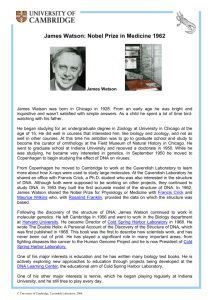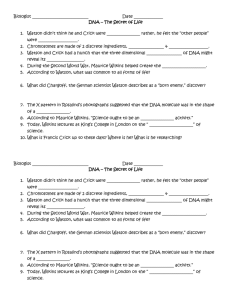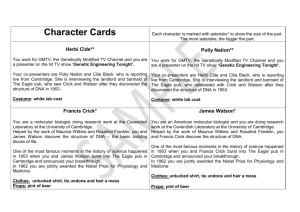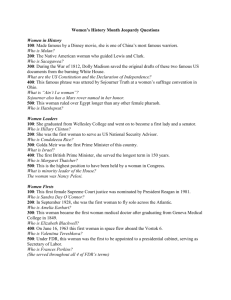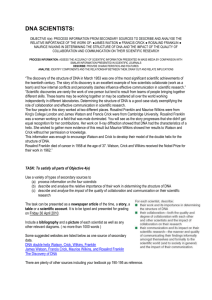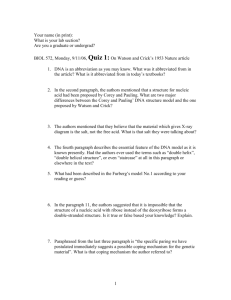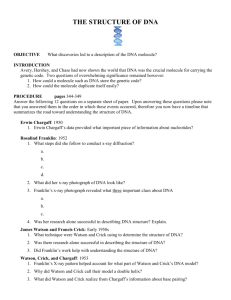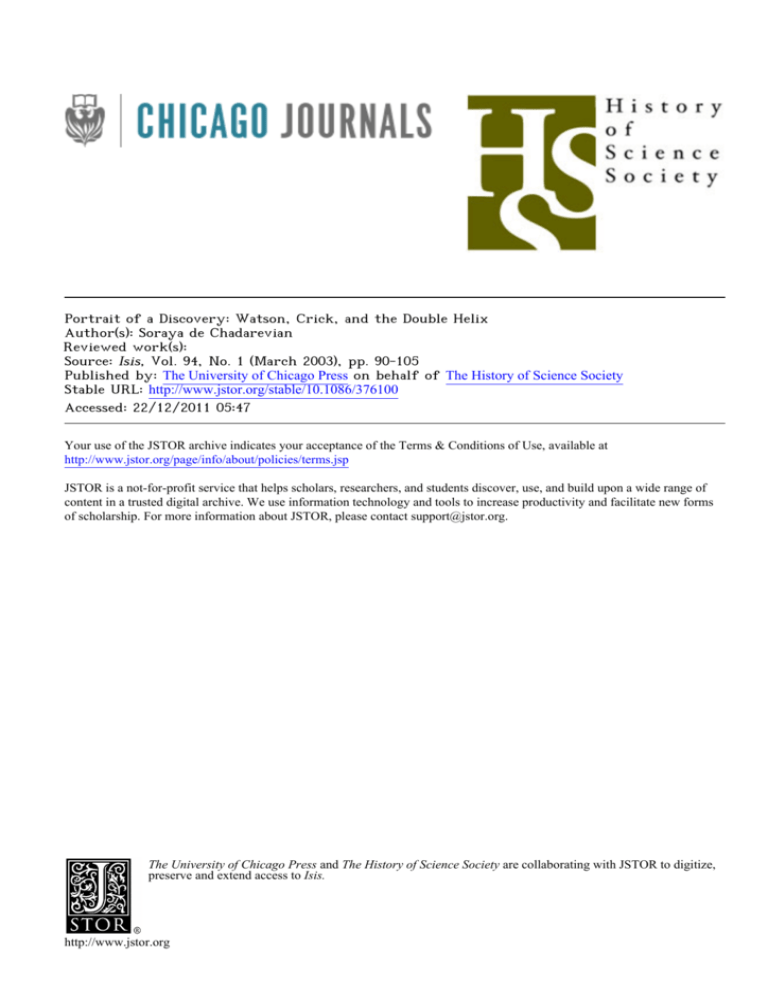
Portrait of a Discovery: Watson, Crick, and the Double Helix
Author(s): Soraya de Chadarevian
Reviewed work(s):
Source: Isis, Vol. 94, No. 1 (March 2003), pp. 90-105
Published by: The University of Chicago Press on behalf of The History of Science Society
Stable URL: http://www.jstor.org/stable/10.1086/376100 .
Accessed: 22/12/2011 05:47
Your use of the JSTOR archive indicates your acceptance of the Terms & Conditions of Use, available at .
http://www.jstor.org/page/info/about/policies/terms.jsp
JSTOR is a not-for-profit service that helps scholars, researchers, and students discover, use, and build upon a wide range of
content in a trusted digital archive. We use information technology and tools to increase productivity and facilitate new forms
of scholarship. For more information about JSTOR, please contact support@jstor.org.
The University of Chicago Press and The History of Science Society are collaborating with JSTOR to digitize,
preserve and extend access to Isis.
http://www.jstor.org
NOTES AND DOCUMENTS
Portrait of a Discovery
Watson, Crick, and the Double Helix
By Soraya de Chadarevian*
ABSTRACT
This essay examines an iconic image of twentieth-century science: Antony Barrington
Brown’s photograph of James Watson, Francis Crick, and the double-helical model of
DNA. The detailed reconstruction of the production, reception, and uses of the photograph
reveals the central role of the image in making the discovery it portrays. Taken in May
1953, two full months after the scientists built the model, to accompany a report on the
structure in Time magazine, the photograph (like the report) was never published. It came
into circulation only fifteen years later, as an illustration in Watson’s best-selling book The
Double Helix. While the image served as a historical document and advertisement for the
book, only the book provided the description that made the image as well as the people
and the model it represented famous. The history of the image provides insights into the
retrospective construction of the discovery, which has since been celebrated as the origin
of a new science of life.
T
HE BLACK-AND-WHITE PHOTOGRAPH of James Watson and Francis Crick gazing at a spidery model of DNA is a cultural icon. It appears in textbooks and on book
covers, posters, celebratory items, and advertisements, and it will be hard to avoid this
year, the fiftieth anniversary of the two researchers’ proposal of DNA’s double-helical
structure (see the cover illustration). The image is seen as a historical document of their
* Department of History and Philosophy of Science, University of Cambridge, Free School Lane, Cambridge
CB2 3RH, England.
I thank Antony Barrington Brown, Rebert Bud, Clare Bunz, Francis Crick, Michael Fuller, Roger Lucke,
Hilary Muirhead, Ann Newmark, Peter Pauling, Nicola Perrin, and Claudio Villa for their crucial help in reconstructing the history of the picture and the model it represents. Earlier versions of this essay were presented at
the conference “Portraiture and Scientific Identity,” organized by Ludmilla Jordanova at the National Portrait
Gallery in London, June 2000, as well as to audiences in Hamburg and Cambridge. I thank the organizers and
participants for useful discussions; Patricia Fara, Nick Hopwood, and Sybilla Nikolow, as well as the Isis referees,
for generous reading and insightful comments on earlier versions of the text; and Jim Secord for numerous
conversations and special help throughout the project.
Isis, 2003, 94:90–105
䉷 2003 by The History of Science Society. All rights reserved.
0021-1753/03/9401-0004$10.00
90
SORAYA DE CHADAREVIAN
91
momentous achievement and a symbol of the era of DNA it allegedly inaugurated. The
significance attributed to recent studies of DNA, especially the sequencing of the human
genome, has increased the symbolic value of the original event and of the image that has
come to represent it. Together with the portrait of Albert Einstein with hooded eyes and
halo of white hair, associated with the formula E ⳱ mc2, and the image of the mushroom
cloud, the photograph represents the salient scientific discoveries of the twentieth century.1
As with other well-known pictures, we “recognize” the Watson-Crick-and-the-doublehelix photograph rather than look at it. Here I propose to examine it more carefully. I shall
reconstruct the occasion on which the image was produced and explore how it was received
and used. The investigation will tell us more not only about the picture itself and how it
acquired its iconic status but also about its role in the making of the discovery it purportedly
portrays. Historians have long pointed out that discovery accounts are retrospectively constructed. The story told here highlights the role of images in these processes. Building on
an increasing number of studies on visual representations in and of the sciences, it underlines the value of images as historical sources.2
DATING THE PHOTOGRAPH
When asked about the picture, most people react strongly. They like it or, much more
rarely, dislike it. But even those who dislike the way it celebrates the male heroes in relation
to the model agree on the photograph’s aesthetic qualities. Besides appreciating its appeal
as a photograph, viewers see the significance of the picture in the momentous discovery
it documents. The picture, they assume, was taken at the announcement of the discovery,
possibly at a press conference.3 The work was honored with the Nobel Prize shared by
Watson, Crick, and Maurice Wilkins; Rosalind Franklin, on whose experimental data Watson and Crick’s structure strongly depended, had died several years earlier and thus could
not be considered for the award. The importance of the event seems to explain the prominence of the photograph and its wide distribution.
Is there more to say about the picture? Indeed, a closer look at the production and
reception of the photograph reveals a much more complex and intriguing story. Let us start
by looking more carefully at the picture itself and reconstructing the occasion on which
the photograph was taken.
1
On Einstein’s portrait as a cultural icon see Alan J. Friedman and Carol C. Donley, Einstein as Myth and
Muse (Cambridge: Cambridge Univ. Press, 1985).
2
On the retrospective construction of discovery accounts see, e.g., Augustine Brannigan, The Social Basis of
Scientific Discoveries (Cambridge: Cambridge Univ. Press, 1981). For the double-helix story in particular see
Pnina G. Abir-Am, “Essay Review: How Scientists View Their Heroes: Some Remarks on the Mechanism of
Myth Construction,” Journal of the History of Biology, 1982, 15:281–315; and Abir-Am, “Themes, Genres, and
Orders of Legitimation in the Consolidation of New Scientific Disciplines: Deconstructing the Historiography
of Molecular Biology,” History of Science, 1985, 23:73–117. On representations in the sciences and their historical analysis see Gordon Fyfe and John Law, eds., Picturing Power: Visual Depiction and Social Relations
(London/New York: Routledge, 1988); Michael Lynch and Steve Woolgar, eds., Representation in Scientific
Practice (Cambridge, Mass.: MIT Press, 1990); Brian S. Baigrie, Picturing Knowledge (Toronto: Univ. Toronto
Press, 1996); Alex Soojung-Kim Pang, “Visual Representation and Post-Constructivist History of Science,”
Historical Studies in the Physical Sciences, 1997, 28:139–171; Caroline A. Jones and Peter Galison, eds.,
Picturing Science, Producing Art (New York/London: Routledge, 1998); and Ludmilla Jordanova, “And?” British
Journal for the History of Science, 2002, 35:341–345. For a useful introduction to the role of images in general
historical research see Peter Burke, Eyewitnessing: The Uses of Images as Historical Evidence (London: Reaktion, 2001), although I don’t follow here Burke’s preference for the term “evidence” in lieu of “source.”
3
See also, e.g., the figure caption in Edward Edelson, Francis Crick and James Watson and the Building
Blocks of Life (New York/Oxford: Oxford Univ. Press, 1988), p. 67.
92
PORTRAIT OF A DISCOVERY
As readers more familiar with the image will know, it comes in two versions. One shows
Crick with a slide rule in his hand pointing up toward the model. In the other slightly less
staged version his arm has moved down, and instead of gazing intently at their model the
two men half-face the viewer, laughing mischievously. Although both images are in wide
circulation, the second one is reproduced somewhat less frequently, and some refer to it
as the “lesser” print, in contrast to the “true” or “classic” picture. The two images are part
of a series of eight shots taken by the Cambridge photographer Antony Barrington Brown
(see Figure 1). One of the photographs showing the pair drinking tea in their office (contact
print 5) is also in circulation. The other images have rarely been published.
Antony Barrington Brown had studied chemistry at Cambridge University (1948–1951)
and came back to the city in 1952 to settle down as a freelance photographer.4 He ran a
little studio in Jesus Lane, opposite the Amateur Dramatic Club Theatre, in a building
demolished in the late 1950s when the street was enlarged. One of the main projects he
undertook was to photograph scientists in their “natural habitat”—that is, in their laboratories. This represented a break from conventional studio portraiture. His subjects did
not pose with one emblematic object of their specialty—for instance, the microscope that
accompanied so many portraits of nineteenth-century physicians, signifying their embrace
of scientific medicine. Rather, Barrington Brown aimed to capture scientists in their individual work environments. Between 1952 and 1958, when he left photography to become
an inventor, he produced many hundreds of such portraits. His main clients were the
colleges that commissioned the photographs for their Senior Common Rooms. Recently
the National Portrait Gallery in London acquired about two hundred of his photographs.5
Although unusual in showing two scientists, the Watson and Crick photographs display
the same style as Barrington Brown’s other portraits. While their poses are certainly staged
(if informally so, with Watson half-sitting on a table and Crick resting his hand on a
propped-up leg), the two scientists are captured in their everyday dress. Ties were part of
the dress code at the Cavendish, the Physics Department at Cambridge in which Watson
and Crick pursued their work, yet shirts and jackets are nonchalantly worn. Crick’s tweed
jacket, that quintessential British garment, has elbow patches and shows reinforcements at
the cuffs, as were frequently seen among academics at the time; Watson’s belt—in lieu of
suspenders—betrays him as a casually dressed American. Their model is rather imperfectly staged against a laboratory brick wall showing taps and wiring. A diagrammatic
drawing of the model is provisionally pinned to the wall.6
I am grateful to Antony Barrington Brown for the following biographical details.
A few nineteenth-century artists depicted scientists in their laboratories, but this did not become common
practice until well after World War II. Photography facilitated the trend. See Ludmilla Jordanova, Defining
Features: Scientific and Medical Portraits, 1660–2000 (London: Reaktion, in Association with the National
Portrait Gallery, 2000), p. 41. A further distinction, it seems to me, is that nineteenth-century depictions tend to
focus on the laboratory or workplace setting itself rather than on the people represented, most strikingly so in
the renderings of Darwin’s study in which he himself is not present except through the traces of his work. See
Janet Browne, “I Could Have Retched All Night: Charles Darwin and His Body,” in Science Incarnate: Historical
Embodiments of Natural Knowledge, ed. Christopher Lawrence and Steven Shapin (Chicago: Univ. Chicago
Press, 1998), pp. 240–287, on pp. 279–280. On photographic images of scientists see also Daniel Jacobi and
Bernard Schiele, “Scientific Imagery and Popularized Imagery: Differences and Similarities in the Photographic
Portraits of Scientists,” Social Studies of Science, 1989, 19:731–753.
6
I thank Graham Howes of Trinity Hall for a fascinating tour through the college photo albums. On the history
of the Medical Research Council Unit in the Cavendish, in which Watson and Crick performed their research,
and for a contextualized account of their work see Soraya de Chadarevian, Designs for Life: Molecular Biology
after World War II (Cambridge: Cambridge Univ. Press, 2002). Watson was a postdoctoral researcher in the
laboratory from 1951 to 1953; Crick joined the unit in 1949 and continued working in the laboratory and its
successor institution, the Medical Research Council Laboratory of Molecular Biology, until the mid 1970s, when
he moved, first provisionally and then permanently, to the Salk Institute in La Jolla, California.
4
5
SORAYA DE CHADAREVIAN
93
Figure 1. Contact prints of the photographs taken by Antony Barrington Brown of Watson, Crick, and
their model in the Cavendish (1953). Courtesy Antony Barrington Brown.
While so much can be reconstructed quite easily, the occasion and the date on which
the photographs were taken and when they first appeared in print are much less clear. The
difficulties in settling these matters may seem surprising, since all three participants are
still alive—or maybe this explains the problems. Yet these very difficulties are indicative
of the new meanings both the photographs and the events they supposedly portray have
acquired retrospectively.7
To appreciate the differences among the existing accounts of the occasion on which the
7
In the reconstruction of events surrounding the production and circulation of the photograph I have made
extensive use of oral communications, although these have been checked against written sources wherever
possible. On the virtues and pitfalls of oral sources see Soraya de Chadarevian, “Using Interviews to Write the
History of Science,” in The Historiography of Contemporary Science and Technology, ed. Thomas Söderqvist
(London: Harwood, 1997), pp. 51–70.
94
PORTRAIT OF A DISCOVERY
photographs were taken, it will be useful to recall that the first brief communication of
Watson and Crick’s proposed structure of DNA appeared in Nature on 25 April 1953. It
was accompanied by two papers by the King’s College group that included corroborating
data as well as Rosalind Franklin and Raymond Gosling’s X-ray diffraction picture of
DNA that, as later became known, gave Watson and Crick crucial clues for the structure
determination. A longer paper by Watson and Crick, in which they spelled out the genetic
implications of the structure, appeared in Nature five weeks later, on 30 May. A fuller
description of the proposed structure appeared in the Proceedings of the Royal Society the
following year.8 The first communication in Nature contained a diagrammatic sketch of
the double helix drawn by Crick’s wife Odile; the last paper included photographs of a
rough scale model of the structure; but none of the papers featured the model shown in
Barrington Brown’s photographs. With this information in mind, let us listen to the recollections of the protagonists.
Watson reportedly believed that the pictures were taken in May 1953, shortly after the
first publication in Nature, and that they first appeared in Varsity, the Cambridge student
weekly. Varsity did indeed carry a brief note on Watson and Crick’s “X-ray discovery” on
30 May, the day of the second publication, but it included no pictures.9
Crick remembered that the photographs were taken on the occasion of an open day at
the Cavendish. According to his recollection, it was only for that occasion that he and
Watson built up the model to full height as it appears in the photograph, using all available
model-building parts. But that year the Cavendish opened its doors to the public on
14–15 July, a date Crick himself cannot make coincide with his memories. A diary entry
of a Rockefeller Foundation officer confirms that “a huge model about six feet tall” was
up when he visited the laboratory in early April—that is, even before the first publication.10
Yet Crick’s recollection, even if not reliable with respect to the dating, is important for
another reason. It makes it clear that the model in Barrington Brown’s picture, which is
generally referred to as the “original” model, is not Crick and Watson’s actual working
model. Rather, there were several models. Crick recalls:
Of course we built the hopelessly incorrect model we showed to the King’s people, but after
that we were forbidden to build any more models. After Pauling’s paper arrived we got permission (both from Bragg and Maurice) to try again. Jim ordered metal models of the bases
(of which we had none before) but we became impatient and made make-shift paper ones, with
which we discovered the AT, GC pairs.
8
James D. Watson and Francis H. C. Crick, “Molecular Structure of Nucleic Acids,” Nature, 1953, 171:737–
738; Maurice H. F. Wilkins, Alexander R. Stokes, and Herbert R. Wilson, “Molecular Structure of Deoxypentose
Nucleic Acids,” ibid., pp. 738–740; Rosalind Franklin and Raymond G. Gosling, “Molecular Configuration in
Sodium Thymonucleate,” ibid., pp. 740–741; Watson and Crick, “Genetical Implications of the Structure of
Deoxyribonucleic Acid,” ibid., pp. 964–967; and Crick and Watson, “The Complementary Structure of Deoxyribonucleic Acid,” Proceedings of the Royal Society: Series A, 1954, 223:80–96. For a detailed reconstruction
of the work leading to Watson and Crick’s proposal of their double-helical model of DNA and the relations
between the Cambridge unit, directed by Max Perutz and working under the patronage of Lawrence Bragg in
the Physics Department, and the King’s College group, led by John T. Randall, see Robert Olby, The Path to the
Double Helix: The Discovery of DNA (New York: Dover, 1994). On Franklin’s role in particular see the references
cited in note 20, below.
9
Archive staff, Cold Spring Harbor Laboratory, New York, June 2000 (reporting Watson’s recollection); and
“X-Ray Discovery,” Varsity, 30 May 1953, p. 1. Intriguingly, just next to the note on Watson and Crick’s discovery
is a photograph of a punt race credited to Barrington Brown, which indicates that the photographer did work for
Varsity. I thank Annette Faux for drawing my attention to this.
10
Francis Crick to Soraya de Chadarevian, 2 June 1997, 5 Jan. 1998; and Gerard Roland Pomerat, diary entry,
1 Apr. 1953, Record Group 1.1, Series 401, Box 44, Folder 567, Rockefeller Archives Center, North Tarrytown,
New York.
SORAYA DE CHADAREVIAN
95
After that we immediately started to build models, but using only one sugar-phosphate, plus
one extra atom, and using a constraint to allow for the base pairs. We built at least two fairly
similar models, of which one is the published one.
I think I was wrong to suggest that we went straight from this to the tall, open-day one. We
probably built a shorter model, with both chains, and perhaps a couple of base pairs, but my
recollection is that for the open day we used everything we had to build as big a one as
possible.11
If we follow Crick’s account, we must assume that it was the lack of any photographic or
other traces of the earlier models that turned the demonstration model, captured in Barrington Brown’s photographs, into the “original” one. I shall return to this point later.
Barrington Brown’s recent account of the story behind the pictures best fits the available
evidence, but here too important details remain unclear. According to his version, there
was a student at Cambridge (“Tim something”) who was paid by Time magazine to look
out for newsworthy stories about Cambridge science. He found out about Watson and
Crick’s model and asked Barrington Brown to take a picture to accompany his report.
A letter Watson wrote to Max Delbrück, his mentor at the California Institute of Technology, on 21 May 1953 does indeed confirm that a reporter from Time (a photographer
is not mentioned) visited the laboratory to see Lawrence Bragg, the Cavendish Professor
and keen supporter of the X-ray crystallography group in his department. According to
Watson’s brief remark, the visit was prompted by and “immediately” followed a report of
the discovery in the News Chronicle. On 15 May—not 12 May, as is sometimes given in
the literature—this London daily did indeed carry a brief front-page article on the DNA
structure by the renowned science writer Richie Calder. The report followed a talk on the
subject by Bragg, an acquaintance of Calder’s, in London.12 The timing broadly corresponds to—or at least does not contradict—the date of 21 May marked on Barrington
Brown’s contact prints, which in turn roughly fits with Watson’s recollections. If the photographer developed the film on the day he took the photographs, as seems to have been
his habit, we can assume that his (unannounced) visit to the laboratory took place after
Watson had written his letter to Delbrück; this would explain why it is not mentioned
there.
Barrington Brown’s reconstruction of the circumstances that led him to the Cavendish
shows that his photographs were not official ones commissioned by the laboratory; a press
conference of the sort staged for scientific announcements today would have been even
more unlikely in 1950s British academic culture. Instead, the origin of the photographs
was rather fortuitous.
More central to the fate of the picture is the fact that Time magazine did not publish the
story and Barrington Brown got his negatives back. Yet according to his memory, a few
years later Time asked permission to use the image for one of its Time-Life Books. This,
he believes, was the first time the photograph (the one with Crick pointing up at the model)
appeared in print.
Crick to de Chadarevian, 5 Jan. 1998.
James Watson to Max Delbrück, 21 May 1953, California Institute of Technology Archives, Pasadena,
quoted in Olby, Path to the Double Helix (cit. n. 8), p. 421; and Richie Calder, “Why You Are You: Nearer the
Secret of Life,” News Chronicle, 15 May 1953, p. 1. This first media report, which followed nearly three weeks
after the publication of the new structure in Nature and a good two months after the completion of the model,
did not mention Watson’s and Crick’s names. On the media coverage of Watson and Crick’s structure of DNA
and the fact that it was rather more modest than is now generally assumed see Edward Yoxen, “The Social
Impact of Molecular Biology,” Ph.D. diss. (Cambridge Univ., 1978), pp. 231–275; and Jon Turney, Frankenstein’s Footsteps: Science, Genetics, and Popular Culture (New Haven, Conn./London: Yale Univ. Press, 1998),
pp. 135–138.
11
12
96
PORTRAIT OF A DISCOVERY
Despite intensive searching, and with Time apparently having disposed of its archive, I
was unable to verify this first use of the picture. What seems certain, however, is that for
many years thereafter the photograph was not used in print. Even around the time of the
Nobel award (1962) there is no trace of it. The photographer also appears to have forgotten
about his picture. Contrary to expectation, then, the initial fate of the picture was one of
prolonged obscurity. This story fits with other evidence indicating that despite the interest
Watson and Crick’s work sparked in some scientific circles, throughout the 1950s and into
the 1960s the double helix did not play the role it does today, either in the public imagination or in historical accounts. Scientific evidence for the structure accumulated and
warranted the 1962 Nobel award. Yet to turn the double helix and the Barringtown Brown
photograph into icons of twentieth-century science, more was needed.13 Before pursuing
this point, let us look more closely at the photograph itself and its iconography.
A PORTRAIT OF WHAT?
Having settled, as far as possible, the circumstances in which the picture was taken, what
can we say about its construction?
Barrington Brown remembers that his brief was to photograph the model. Yet despite
his chemical background, the “primitive molecular model” he saw at the Cavendish did
not mean much to him. Nor was he impressed by its aesthetic qualities. It looked to him
like a piece of engineering rather than chemistry, and he did not find it at all photogenic.
To make the picture more attractive, he posed Watson and Crick in front of the model,
asking them “to point to it [the use of the slide rule was his suggestion] and look portentous.” This—Barrington Brown remarks about his own photograph—“as you can see
they lamentably failed to do.”14
The relation between the model and the scientists remains ambiguous: is this a picture
of the model and its makers or of the two researchers and their model? One source of
ambiguity lies in the pointing gesture: while attention is directed toward the model, the
act of drawing attention to it falls to the researcher. Similarly, Watson’s lost gaze expresses
as much awe of the model that towers over him as of the people, himself included,
13
On the place of the double helix in historical accounts of molecular biology see de Chadarevian, Designs
for Life (cit. n. 6), esp. Pt. 2. On the initial fragility of Watson and Crick’s proposed structure, the scientific
arguments brought against it (especially the “untangling problem” during replication), and the subsequent corroboration of their work see Michel Morange, A History of Molecular Biology (Cambridge, Mass.: Harvard Univ.
Press, 1998), pp. 116–117; and Frederic L. Holmes, Meselson, Stahl, and the Replication of DNA: A History of
the Most Beautiful Experiment in Biology (New Haven, Conn.: Yale Univ. Press, 2001), esp. pp. 11–48. Direct
crystallographic proof for the double-helical structure of DNA came only in the early 1980s.
14
Roger Hargreaves, ed., Faces of the Century: A Sainsbury’s Photographic Exhibition: A National Portrait
Gallery Resource Pack for Teachers (London: National Portrait Gallery, 1999), p. 7; and Antony Barrington
Brown, telephone conversation with de Chadarevian, Jan. 1995. Barrington Brown’s photograph was chosen by
Stephen Hawking, Lucasian Professor of Mathematics at Cambridge and the author of the best-selling A Brief
History of Time (New York: Bantam, 1988), for inclusion in the exhibition at the National Portrait Gallery. The
photographer’s initial impression contrasts starkly with the scientists’ repeated reference to the “beauty” of the
model; see, e.g., James D. Watson, The Double Helix: A Personal Account of the Discovery of the Structure of
DNA: Text, Commentary, Reviews, Original Papers, ed. Gunther Stent (New York/London: Norton, 1980) (hereafter cited as Watson, Double Helix, ed. Stent), pp. 120, 124. It strongly suggests that the model was “beautiful”
or “pretty” only to those who understood the basic simplicity of the proposed structure and its implications. The
diagrammatic drawing of the model pinned on the wall behind it, possibly the original of the one published in
the first paper in Nature, may well have served to help visitors comprehend and appreciate the structure. If
laypeople today share scientists’ view when looking at the reconstructed model, it is because they “know” about
its importance, even if they cannot grasp the structural details. On aesthetic judgments in scientific experimentation see Holmes, Meselson, Stahl, and the Replication of DNA (cit. n. 13).
SORAYA DE CHADAREVIAN
97
who constructed it. A similar ambiguity is present in other pictures of molecular biologists,
in which their models often seem to take center stage.15 Yet in the history and public
presentation of the DNA story this question has taken on a special twist, and it has sometimes remained unclear whether Watson and Crick or the double helix deserved more
credit. Crick reinforced this ambiguity in his autobiography when—perhaps in reaction to
Watson’s race-for-fame account of their common work—he emphatically remarked: “What
was important was not the way it was discovered but the object discovered—the structure
of DNA itself. . . . So, as I have said before: It is the molecule that has the glamour, not
the scientists.” And a bit further on: “Rather than believe that Watson and Crick made the
DNA structure, I would rather stress that the structure made Watson and Crick.” And
although Watson and Crick certainly got their share of credit, even at the expense of other
participants, the double helix has at times taken the place of the scientists. The “Crick
window,” a stained-glass window that decorates the dining hall in Gonville and Caius,
Crick’s first Cambridge college, is a striking example: it shows only his name, followed
by the dates of his college affiliation, and the helix.16
On other occasions, as well, the helix has acquired “hero” status. It is certainly the most
celebrated of all molecules. Its twenty-first and fortieth anniversaries were celebrated in
style, and its fiftieth promises to be an even grander occasion. Many painters and sculptors,
starting with Salvador Dalı́, have tried their hand at it, and several books have been dedicated to it.17 Yet in the end, for Barrington Brown’s photograph to take on the significance
it did, it was important that it represented both the model and its makers.
LITERARY SUCCESS
The publication in 1968 of The Double Helix, Watson’s passionate account of his collaboration with Crick and the events leading to the proposal of the double-helical structure of
DNA, dramatically changed the fate of the 1953 photograph.18
The book created a scandal even before it was published. The New York Times reported
on the front page that in a nearly unprecedented move, the Harvard Corporation had
15
For some brief remarks on portraits of scientists and their molecular models see Eric Francoeur, “The
Forgotten Tools: The Design and Use of Molecular Models,” Soc. Stud. Sci., 1997, 27:7–40.
16
Francis H. C. Crick, What Mad Pursuit: A Personal View of Scientific Discovery (Harmondsworth, Middlesex: Penguin, 1990), pp. 67, 76. For an image of the window see Soraya de Chadarevian and Harmke Kamminga,
Representations of the Double Helix [Exhibition Catalogue] (Cambridge: Whipple Museum of the History of
Science, 2002), p. 29.
17
See de Chadarevian and Kamminga, Representations of the Double Helix. Discounting the modern “publicity
carnival” surrounding the double helix (Erwin Chargaff, “The Tower of Babel,” Nature, 1974, 249:776–797, on
p. 778), the case can perhaps be compared to that of the orrery, a mechanical model of the planets’ movements
around the sun representing Newtonian science and depicted in Joseph Wright’s well-known painting: see Patricia
Fara, Newton: The Making of a Genius (London: Macmillan, 2002), p. 22. On commemorative practices in the
sciences see Pnina G. Abir-Am, “A Historical Ethnography of a Scientific Anniversary in Molecular Biology:
The First Protein X-Ray Photograph (1984, 1934),” Social Epistemology, 1992, 6:323–354 (and also comments
and responses that follow; pp. 355–387); Abir-Am and Clark A. Elliott, eds., Commemorative Practices in
Science: Historical Perspectives on the Politics of Collective Memory, Osiris, 1999, 14; and Bernadette BensaudeVincent, “Between History and Memory: Centennial and Bicentennial Images of Lavoisier,” Isis, 1996, 87:481–
499. On the role of visual representations in scientific commemorations more explicitly see Ludmilla Jordanova,
“Presidential Address: Remembrance of Science Past,” Brit. J. Hist. Sci., 2000, 33:387–406. For the systematic
analysis of the depictions and commemorations of individual scientific “heroes” see Marco Beretta, Imaging a
Career in Science: The Iconography of Antoine Lavoisier (Canton, Mass.: Science History Publications, 2001);
and Fara, Newton.
18
James Watson, The Double Helix: A Personal Account of the Discovery of the Structure of DNA (New York:
Atheneum; London: Weidenfeld & Nicolson, 1968).
98
PORTRAIT OF A DISCOVERY
overruled the university’s Board of Syndics and ordered Harvard University Press not to
publish the book. The action followed firm opposition to publication by some of the story’s
key protagonists. When the book finally appeared from a commercial press, readers were
shocked by Watson’s irreverent way of writing about scientists and their pursuits. The
Double Helix quickly became a best-seller and has been through many editions since. It
has been translated into eighteen different languages and is widely used in the classroom.19
Historians have pointed out that the competitive and ruthless behavior of scientists
celebrated in the book was more characteristic of the late 1960s than of Cambridge in the
early 1950s. Yet the story of the double helix did not simply give this new reality a romantic
gloss; the glorification of this new way of doing science also aimed to justify the conduct
of Watson and Crick in relation to the King’s College group and especially their use of
Franklin’s unpublished data, which remained a source of embarrassment. As is well known,
Watson’s representation of Franklin’s role provoked the opposite reaction. In this respect
the book backfired.20
The Double Helix contained a series of illustrations, among which was Barrington
Brown’s photograph of Watson and Crick in front of the model (the one with the slide rule
pointing up). This image came from Watson’s personal collection (the photographer must
have given him a copy at the time), later deposited in the Cold Spring Harbor Laboratory
Archives. It was not the only picture of the two principal characters in the DNA story and
of their model. There was the photograph of Watson and Crick drinking tea from the same
series and an informal shot of the two researchers walking along the “backs,” the college
back gardens in Cambridge, with King’s College Chapel in the background (see Figure
2). As Watson suggested in his book, it was on these after-lunch walks that he and Crick
developed their boldest and most fruitful ideas. That picture is on the cover of the 1980
critical edition of The Double Helix. One other photograph in the book also showed the
model, close up (see Figure 3).21 Yet none of these other pictures seemed to capture
19
Walter Sullivan, “A Book that Couldn’t Go to Harvard,” New York Times, 15 Feb. 1968, pp. 1, 4, rpt. in
Watson, Double Helix, ed. Stent, pp. xxiv–xxv; and Brenda Maddox, Rosalind Franklin: The Dark Lady of DNA
(London: HarperCollins, 2002), p. 314 (eighteen languages).
20
On the depiction of ruthless competition see Edward Yoxen, “Speaking Out about Competition: An Essay
on ‘The Double Helix’ as Popularisation,” in Expository Science: Forms and Functions of Popularisation, ed.
Terry Shinn and Richard Whitley (Sociology of the Sciences Yearbook, 9) (Dordrecht: Reidel, 1985), pp. 163–
181. On Franklin see Aaron Klug, “Rosalind Franklin and the Discovery of the Structure of DNA,” Nature,
1968, 219:808–810, 843–844, rpt. in Watson, Double Helix, ed. Stent, pp. 153–158; André Lwoff, “Truth,
Truth, What Is the Truth (about How the Structure of DNA Was Discovered)?” Scientific American, 1968,
219:133–138, rpt. ibid., pp. 224–234; Anne Sayre, Rosalind Franklin and DNA (New York: Norton, 1975); and
Maddox, Rosalind Franklin (cit. n. 19).
21
To my knowledge this is the only extant picture, apart from Barrington Brown’s series, of the “original”
model. Yet it is much more rarely reproduced than Barrington Brown’s photograph. The photographer is unknown. Intriguingly, the model is not only displayed in a different manner than in the Barrington Brown photograph: apparently standing on the floor, instead of on a low table, and placed in front of a dark curtain. It also
is more intact than the one in the other pictures, where, in one of the unpublished shots, we see Crick connecting
some broken-off parts (see Figure 1, contact print 1). One possible interpretation is that this is the photograph
Crick remembers being taken at the open day and that on that occasion the model was, if not actually built up—
the number of base pairs shown in both photographs is the same—at least “repaired” as well as more effectively
staged against a dark background. Michael Fuller, then the laboratory assistant in the unit, supports this interpretation. It would suggest that this photograph, too, was taken by a professional photographer. It may seem
rather surprising that neither Crick nor Watson nor one of the visitors who came to see the model took a
photograph of it. Yet Peter Pauling, then visiting from America, confirms that he took his 2 ⳯ 2 Rolleiflex
around town to photograph colleges but never brought it into the laboratory. The only photographs he took in
the lab were two snapshots of Crick, which he took as a joke with the microscope camera of one of the researchers
(Peter Pauling, personal communication; one of the photographs is reproduced in Watson, Double Helix [cit.
n. 18], p. 11). Besides the fact that private cameras were brought along to leisurely pursuits rather than to the
SORAYA DE CHADAREVIAN
99
Figure 2. Crick ( left ) and Watson (right) on a walk along the “backs” in Cambridge. In the background
is King’s College Chapel. Photograph by Herbert Gutfreund. From The Double Helix by James D. Watson, Atheneum Publishers, 1968. Courtesy of the James D. Watson Collection, Cold Spring Harbor
Laboratory Archives.
Watson’s story as well as Barrington Brown’s. Indeed, in many of the paperback editions
it appeared on the front cover. From there it has, more recently, advanced to advertise an
initiative celebrating the “Books of the Century”—among which, of course, The Double
Helix was included.22
After its publication in Watson’s book, demand for the picture rose steadily. It was
distributed by Camera Press, the London-based photo agency that represented the photographer, as well as by several other institutions. Only in the early 1990s did Barrington
Brown start to realize how much he was losing on royalties. He is now pursuing his
copyright (and former breaches of it) vigorously. This circumstance and the fact that invoices by Camera Press were not itemized make it impossible to obtain exact figures on
the actual circulation of the photograph, but undoubtedly demand grew continuously from
workplace (Philip Stokes, “The Family Photograph Album: So Great a Cloud of Witnesses,” in The Portrait in
Photography, ed. Graham Clarke [London: Reaktion, 1992], pp. 200–201), flashes were not common before the
1960s, which limited the indoor use of cameras by amateur photographers. On the rise of popular photography
see Brian Coe and Paul Gates, The Snapshot Photograph: The Rise of Popular Photography, 1888–1939 (London:
Ash & Grant, 1977); and Colin Ford and Karl Steinorth, eds., You Press the Button, We Do the Rest: The Birth
of Snapshot Photography (London: Nishen, in association with the National Museum of Photography, Film, and
Television, 1988). On the social meaning of photography see Pierre Bourdieu, Photography: A Middle-Brow Art
(London: Polity, 1990).
22
Waterstone’s Booksellers, advertising campaign, autumn 1999. The book is also listed in The New York
Public Library’s Books of the Century (Oxford: Oxford Univ. Press, 1995).
100
PORTRAIT OF A DISCOVERY
Figure 3. The DNA model, as displayed at the open day in the Cavendish, July 1953. From The Double
Helix by James D. Watson, Atheneum Publishers, 1968. Courtesy of the James D. Watson Collection,
Cold Spring Harbor Laboratory Archives.
the 1970s. Since 1993 the “classic” print and its companion, as well contact print 5, have
been distributed mainly through Science Photo Library; Camera Press still distributes the
companion of the “classic” print.
The publication of The Double Helix coincided with debates on the “origins” of the new
science of molecular biology. Some participants found the origin in Watson and Crick’s
achievement, which brought together genetic and structural approaches. However, it was
Watson’s book, followed by a BBC television production in 1987, that gave the events
surrounding the proposal of the double-helical structure of DNA even wider currency.
Recent developments, especially the projects to sequence the human genome, have heightened interest in the origin story. The history of the human genome project as represented
in a special insert published in Science in 2001 starts in 1953. Barrington Brown’s photograph illustrates the original event.23
23
Leslie Roberts et al., “A History of the Human Genome Project,” Science, 2001, 291:1195–1200. On the
“origin debate” see Abir-Am, “Themes, Genres, and Orders of Legitimation” (cit. n. 2); and de Chadarevian,
SORAYA DE CHADAREVIAN
101
If in Crick’s view the double helix “made Watson and Crick,” it is equally true that
Watson’s book made the double-helix story and the legend of the photograph. Watson’s
book not only brought Barrington Brown’s picture into circulation but also provided what
became the dominant description of the image. Barrington Brown seems to confirm this
view when he says: “This is a picture of people, the story of two chaps and their interaction
as described in Watson’s book.”24
It is surprising how much of the story as described by Watson we can read into the
picture retrospectively, with regard to both the relation of the two protagonists and their
relation to their model. Crick, in the pose of a classical hero, appears as the dominating
figure and the object of Watson’s admiration. The slide rule in his hand, although it was
not used in the actual work, characterizes him as the calculating type—the one who knows
his crystallography—while Watson’s somewhat baffled expression, with his eyes turned
upward, is that of someone receiving divine inspiration. Yet their boyish enchantment
expresses as much admiration for what was given to them as for their own ingenuity in
“finding” it—an aspect very much celebrated in Watson’s account. The bare laboratory
background underscores the apparent simplicity of the approaches used, a reflection of the
proverbial shoestring-and-sealing-wax approach of 1950s British science, and the genius
of the researchers in achieving a breakthrough discovery. The art historian Martin Kemp
has recently described the model’s style—“linear, wiry, openly mechanical, unadorned,
und rhetorically ‘functional’”—as belonging to the design parameters launched by the
1951 Festival of Britain.25
Watson and Crick’s “failure to look portentous” in the picture, noted by Barrington
Brown, also takes on another meaning. The scientists’ “jokey mood” fits the general mode
according to which molecular biologists of the first generation liked to present themselves:
young, informal, irreverent. We know them not from studio portraits (painted or photographed) but from snapshots taken of them at informal meetings or when involved in
leisurely pursuits; they are shown in baggy trousers and funny hats or with naked torsos—
Watson and other Americans more so than their British colleagues (see Figure 4).26
By coming to symbolize what is increasingly seen as a key event of the twentieth
century, Barrington Brown’s photograph, in mutual reinforcement with Watson’s book,
codifies a particular image of that event and its heroes. That image will be hard to displace,
Designs for Life (cit. n. 6), esp. pp. 166–170. Watson’s contribution, a brief autobiographical piece, to the book
that sparked the debate—a Festschrift for his mentor, Max Delbrück—formed the starting point for his longer
personal account in The Double Helix; see James D. Watson, “Growing Up in the Phage Group,” in Phage and
the Origins of Molecular Biology, ed. John Cairns, Gunther S. Stent, and Watson (Cold Spring Harbor, N.Y.:
Cold Spring Harbor Laboratory of Quantitative Biology, 1966), pp. 239–245. On the 1987 BBC film and other
movies about the DNA story see Crick, What Mad Pursuit (cit. n. 16), pp. 80–81.
24
Barrington Brown, conversation with de Chadarevian, Jan. 1995.
25
Martin Kemp, Visualizations: The Nature Book of Art and Design (Oxford: Oxford Univ. Press, 2000),
p. 121.
26
Barrington Brown, quoted in Hargreaves, ed., Faces of the Century (cit. n. 14), p. 27. A telling exception
to this trend is the image of the British X-ray crystallographer Dorothy Hodgkin, whose best-known portrait, a
painting by Maggi Hambling commissioned by the National Portrait Gallery in London, shows her busy at work.
On the hands in the painting see Jordanova, Defining Features (cit. n. 5), pp. 155–158. On snapshots versus
formal portraits see Christopher Phillips, ed., Photography in the Modern Era: European Documents and Critical
Writings, 1913–1940 (New York: Metropolitan Museum of Modern Art, 1989), pp. 37–40, 238–242. For photographic collections of molecular biologists see Horace F. Judson, The Eighth Day of Creation: Makers of the
Revolution in Biology (London: Penguin, 1994); and Donald A. Chambers, ed., DNA: The Double Helix: Perspective and Prospective at Forty Years (Annals of the New York Academy of Sciences, 758) (New York: New
York Academy of Sciences, 1995).
102
PORTRAIT OF A DISCOVERY
Figure 4. Watson explaining the double helix at the Cold Spring Harbor Symposium in June 1953.
Courtesy of the James D. Watson Collection, Cold Spring Harbor Laboratory Archives.
despite the controversies Watson’s account sparked. Most significantly, Franklin’s X-ray
photograph of the DNA helix, on which the interpretation of the structure crucially relied,
has all but disappeared from the public imagery of the discovery, its space taken by the
photograph of two male heroes and their Meccano-like model.27
RE-ENACTMENTS
Interest in the history of the double helix, spurred by Watson’s book and the development
of new DNA technologies, grew at a time when the tall and fragile demonstration model
27
The case invites comparison with another iconic image of twentieth-century biomedical sciences: the X-ray
image of Mrs. Röntgen’s hand, which shows an equally strong gender inscription. See Lisa Cartwright, Screening
the Body: Tracing Medicine’s Visual Culture (Minneapolis: Univ. Minnesota Press, 1995), esp. p. 115.
SORAYA DE CHADAREVIAN
103
had long since fallen to pieces and most of its parts had disappeared. The model had
survived the move, in 1962, from the Cavendish laboratory to the new Laboratory of
Molecular Biology on the outskirts of Cambridge, but there it became increasingly neglected. What was left of it was finally disassembled and the remaining parts used for
other model-building projects, as is the normal fate for most models. Yet when in the mid
1970s a research assistant of the Science Museum in London by chance discovered in
Bristol some of the original metal bases—the only parts that, because they were purposebuilt, could be positively identified—the museum acquired the pieces and commissioned
Farooq Hussain, a researcher at King’s College London, to reconstruct the model.28
New metal base parts were cut on the pattern of the few surviving ones. Atomic angles
and coordinates as well as the dimensions of the structure were extracted from the published papers, and Watson, Crick, and Wilkins were available for consultation. Yet Barrington Brown’s photograph and the other photograph published in Watson’s book were
the only surviving images of the model and provided crucial information on the many
details not documented in other sources, such as the kind of base used, the construction
of the stand, and the positions of the clamps.29 On completion, the model was found to be
slightly taller than the original one, as measured from the picture, a mistake corrected in
a copy made of the first replica. Both models have been on display in the Science Museum.
Until recently the first one, which incorporates the 1950s base plates acquired from Bristol,
carried the label: “The nearest there is to the original model.” When, on the eve of the
new millennium, the model was moved from the “Health Matters Gallery” to the new
museum gallery “Making the Modern World”—where it competes for the attention of
visitors with a V2 rocket, a Lockhead airliner, a Rolls-Royce Merlin engine, and a vertical
tower of 1950s automobiles, all displayed in close proximity—this caution was brushed
aside. The label, illustrated with Barrington Brown’s photograph—the one with the slide
rule pointing down—now presents the same object simply as “Crick and Watson’s DNA
model, 1953.”30 When in 1987 and again in 2002—the first time for the BBC television
production of Watson’s book, the second time in preparation for the fiftieth anniversary of
the double helix—technicians at the Laboratory of Molecular Biology in Cambridge embarked on reconstructions of the model, Barrington Brown’s photograph once more guided
the work.31
28
The bases had come to Bristol along with other model-building parts packed up for the X-ray crystallographer
Herman Watson (no relation to his more famous namesake) when he moved from Cambridge. They were incorporated in a DNA model built at Bristol and displayed before the entrance to the first-year practical laboratory.
The Bristol model differed “quite substantially” from the original one: Farooq Hussain to Ann Newmark, 5 Oct.
1976, Science Museum, London, File 996/45.
29
In the correspondence relating to the reconstruction of the model, only “one photograph of the original to
work from” is mentioned. Unfortunately, no photograph is included in the file, and it has not been possible to
establish with certainty which image it was. Yet it seems reasonable to assume that it was one of the two known
ones, and probably Barrington Brown’s, which is the only image of the double helix on display in the Science
Museum. The picture used for the reconstruction apparently came from Peter Pauling, who had been a visitor
in the laboratory when Watson and Crick performed their work and was then working in London. Pauling himself
cannot recollect that he has ever been in possession of any picture of the double helix: Hussain to Newmark, 5
Oct. 1976; Ann Newmark, handwritten memo, 2 Nov. 1976, Science Museum, File 996/45; Newmark to de
Chadarevian, 2 July 2002; and Pauling, personal communication. Of course by that time Watson’s book, with
the two pictures of the model, had been in print for several years.
30
Visitors who care to read the text in smaller print will still learn that the model on display was reconstructed
in the 1970s and only includes some original plates.
31
Although faithful in many respects, in some decisive aspects the construction of these two most recent
models deliberately departed from the historical model. Most significantly, the bond lengths and angles used
were based not on Watson and Crick’s original values but on later, more accurate measurements. Watson and
104
PORTRAIT OF A DISCOVERY
These were not the only re-enactments. In 1990 the actual photograph was restaged in
Cold Spring Harbor, with Watson and Crick adopting the same poses in front of their
model that they took forty years earlier in the Cavendish for Barrington Brown’s camera.32
When, on the twenty-fifth anniversary of his directorship of Cold Spring Harbor Laboratory
in 1993, which coincided with the fortieth anniversary of the DNA double helix, Watson
was presented with an impressive bronze double-helix sculpture, he posed next to it with
the same bewitched gaze. The helix, however, has been transformed from “primitive molecular model” to precious piece of art (see Figure 5).
CONCLUSIONS
Watson and Crick’s proposal of the double-helical structure of DNA is among the most
widely celebrated scientific events of the twentieth century. The history of the photograph
Barrington Brown took at the Cavendish in 1953 suggests that the picture is much more
Figure 5. Watson next to the bronze double-helix sculpture by Charles Reina. Grace Auditorium, Cold
Spring Harbor Laboratory, 1993. Courtesy of the James D. Watson Collection, Cold Spring Harbor
Laboratory Archives.
Crick’s assumption that there were two instead of three hydrogen bonds between the two bases guanine and
cytosine has also been corrected. The metal bases were left as shiny as they probably were in Watson and Crick’s
original model but would certainly no longer have been fifty years later. Metal connections and the stand were
slightly altered to make the model more stable and thus prevent it from suffering the same fate as the original.
On the meanings and politics of rebuilds (in this case of computers) see Jon Agar, “Digital Patina: Texts, Spirit,
and the First Computer,” History and Technology, 1998, 15:121–135.
32
See http://www.cshl.org/watson-archives/Previews/watson_cd-141.jpg. I was not able to establish the exact
occasion for the restaging nor whose idea it was. At the time Watson was director of the National Center for
Human Genome Research at the National Institutes of Health and continued promoting DNA research on all
levels; Crick had long since moved to occupying himself with the brain.
SORAYA DE CHADAREVIAN
105
than just a document of the model and its makers at the time. Together with Watson’s bestselling account, it has become part of the making of that discovery and the way it is
represented. This holds true both for what the image shows and for what it excludes.
Barrington Brown’s image did not make an impact straight away. Only Watson’s book,
published fifteen years after the announcement of the structure, brought the photograph
into wider circulation and furnished the account we still broadly associate with it today.
Conversely, the image provided a powerful illustration of Watson’s account, and while
being turned into an icon it reinforced the fame of the story. Paradoxically, then, the fate
of the image has given us insight into the retrospective construction of the event the image
itself represents. Far from diminishing its value, the study of its production and uses
highlights the importance of the image as a historical artifact and source.

